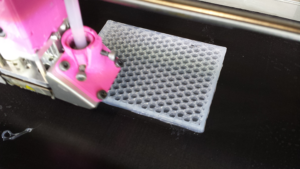It’s safe to say that a lot of people these days rely on their smartphones for all sorts of reasons – from communication to scheduling, and everything in between (sometimes you’re bored and need instant access to Reddit or a cute cat video). So it’s always unfortunate to be stuck somewhere with a phone that’s low on battery and no easy access to an outlet. Maybe you’ve got one one of those portable battery packs, which is great if you’ve got something to carry it in – these can be bulky and therefore hard to slip into your back pocket.
A team of scientists and researchers at Brunel University London are working on a new materials research project, developing a product that makes it so you’re never caught without a charge, no matter where you are.
They have created a technique for 3D printing a flexible supercapacitor that you can wear on your wrist, using silicone and inexpensive supplies that can be purchased at a hardware store. A supercapacitor stores energy just like a battery does, but on its surface, and without any chemical reactions.
Milad Areir, with Brunel’s Cleaner Electronics Research Group, said, “This is the first time a flexible supercapacitor including all its components has been produced by 3D printing. The most popular way to produce them is screen printing, but with that you can’t print the frame of the supercapacitor on silicone.”
We’ve seen research on 3D printable supercapacitors, as well as 3D printed battery chargers powered by the wind and wearable technology powered by sweat, but all of the components for these new electrochemical double layer capacitors (EDLCs) can be 3D printed in the same process. The team uses an open source Ultimaker 2 3D printer that’s connected to a syringe driver with a stopper motor by USB, which extrudes stacks of silicone, glue, and gel electrolyte pastes into layers that eventually form a clear wristband, which contains a supercapacitor.
3D printed flexible supercapacitor research is ongoing in several countries, but the expensive techniques, such as selective laser melting, print different parts out on different machines.
“Our technique brings it all together into one process with one machine. It will definitely save time and costs on expensive materials,” Areir explained.
The researchers conducted a study on their work, which will be published in the December 2017 edition of Materials Science and Engineering; co-authors include Areir, Yanmeng Xu, David Harrison, and John Fyson.
The abstract reads, “The rapid development of flexible energy storage devices is crucial for various applications. However, it is still difficult to manufacture functional flexible electrochemical double layer capacitors (EDLCs) in one single process due to many different types of materials being used in EDLCs. This paper presents a novel method of manufacturing highly flexible EDLCs by using an open source 3D printer. The EDLC components were fabricated using a single paste extrusion in a layer wise manner. The detailed fabrication process for a highly flexible EDLCs device has been demonstrated, where acetoxy silicone was used as the flexible substrate. The purpose of this study has been to develop a single continuous manufacturing process for EDLC and to investigate the electrochemical performances of 3D printed flexible supercapacitors. Mechanical bending tests were carried out to prove the stability of the electrochemical performance and flexibility of the 3D printed supercapacitors.”
Based on the size of the supercapacitor, the team needs three to four syringes for the process, and the flexible wristbands, which exhibit high electrochemical performance, are 3D printed in a honeycomb pattern, which saves on time and material. The study explains that the process is “easy to copy,” and other designers can experiment in order to create more complex shapes. The technique also shows how 3D printing with paste extrusion can use different paste mixtures to create “more sophisticated electronic devices.”
Areir said, “In future it can be used for mobile phones. For example, if the phone battery is dead, you could plug the phone into the supercapacitator wristband and it could act as a booster pack, providing enough power to get to the next charging point.”
The Brunel research team’s technique shows that inexpensive products can be used to make the wristbands, rather than having to rely on expensive semiconductors or metals. The supercapacitor wristbands are able to withstand stress tests without losing power, and in the future, the process could be further developed into novel designs for extremely efficient, wearable power for things like pacemakers and even electric cars.
Discuss this and other 3D printing topics at 3DPrintBoard.com or share your thoughts in the Facebook comments below.
[Images provided by Brunel University London]
Subscribe to Our Email Newsletter
Stay up-to-date on all the latest news from the 3D printing industry and receive information and offers from third party vendors.
Print Services
Upload your 3D Models and get them printed quickly and efficiently.
You May Also Like
Making 3D Printing Personal: How Faraz Faruqi Is Rethinking Digital Design at MIT CSAIL
What if your 3D printer could think more like an intelligent assistant, able to reason through a design idea, ask questions, and deliver something that works exactly the way the...
Reinventing Reindustrialization: Why NAVWAR Project Manager Spencer Koroly Invented a Made-in-America 3D Printer
It has become virtually impossible to regularly follow additive manufacturing (AM) industry news and not stumble across the term “defense industrial base” (DIB), a concept encompassing all the many diverse...
Heating Up: 3D Systems’ Scott Green Discusses 3D Printing’s Potential in the Data Center Industry
The relentless rise of NVIDIA, the steadily increasing pledges of major private and public investments in national infrastructure projects around the world, and the general cultural obsession with AI have...
Formlabs Teams Up with DMG MORI in Japan
In late June, Nick Graham, Chief Revenue Officer at Formlabs, announced on LinkedIn that the company had partnered with DMG MORI, one of the world’s leading machine tool companies, to...






































